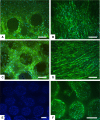Bone-like ceramic scaffolds designed with bioinspired porosity induce a different stem cell response
- PMID: 33471246
- PMCID: PMC7817586
- DOI: 10.1007/s10856-020-06486-3
Bone-like ceramic scaffolds designed with bioinspired porosity induce a different stem cell response
Abstract
Biomaterial science increasingly seeks more biomimetic scaffolds that functionally augment the native bone tissue. In this paper, a new concept of a structural scaffold design is presented where the physiological multi-scale architecture is fully incorporated in a single-scaffold solution. Hydroxyapatite (HA) and β-tricalcium phosphate (β-TCP) bioceramic scaffolds with different bioinspired porosity, mimicking the spongy and cortical bone tissue, were studied. In vitro experiments, looking at the mesenchymal stem cells behaviour, were conducted in a perfusion bioreactor that mimics the physiological conditions in terms of interstitial fluid flow and associated induced shear stress. All the biomaterials enhanced cell adhesion and cell viability. Cortical bone scaffolds, with an aligned architecture, induced an overexpression of several late stage genes involved in the process of osteogenic differentiation compared to the spongy bone scaffolds. This study reveals the exciting prospect of bioinspired porous designed ceramic scaffolds that combines both cortical and cancellous bone in a single ceramic bone graft. It is prospected that dual core shell scaffold could significantly modulate osteogenic processes, once implanted in patients, rapidly forming mature bone tissue at the tissue interface, followed by subsequent bone maturation in the inner spongy structure.
Conflict of interest statement
The authors declare that they have no conflict of interest.
Figures











Similar articles
-
Bone tissue engineering gelatin-hydroxyapatite/graphene oxide scaffolds with the ability to release vitamin D: fabrication, characterization, and in vitro study.J Mater Sci Mater Med. 2020 Oct 31;31(11):97. doi: 10.1007/s10856-020-06430-5. J Mater Sci Mater Med. 2020. PMID: 33135110
-
Porosity and pore size of beta-tricalcium phosphate scaffold can influence protein production and osteogenic differentiation of human mesenchymal stem cells: an in vitro and in vivo study.Acta Biomater. 2008 Nov;4(6):1904-15. doi: 10.1016/j.actbio.2008.05.017. Epub 2008 Jun 11. Acta Biomater. 2008. PMID: 18571999
-
Development, Characterization and In Vitro Biological Properties of Scaffolds Fabricated From Calcium Phosphate Nanoparticles.Int J Mol Sci. 2019 Apr 11;20(7):1790. doi: 10.3390/ijms20071790. Int J Mol Sci. 2019. PMID: 30978933 Free PMC article.
-
[Mechanical properties of polylactic acid/beta-tricalcium phosphate composite scaffold with double channels based on three-dimensional printing technique].Zhongguo Xiu Fu Chong Jian Wai Ke Za Zhi. 2014 Mar;28(3):309-13. Zhongguo Xiu Fu Chong Jian Wai Ke Za Zhi. 2014. PMID: 24844010 Chinese.
-
The role of calcium phosphate surface structure in osteogenesis and the mechanisms involved.Acta Biomater. 2020 Apr 1;106:22-33. doi: 10.1016/j.actbio.2019.12.034. Epub 2020 Jan 9. Acta Biomater. 2020. PMID: 31926336 Review.
Cited by
-
Bone Fillers with Balance Between Biocompatibility and Antimicrobial Properties.Biomimetics (Basel). 2025 Feb 10;10(2):100. doi: 10.3390/biomimetics10020100. Biomimetics (Basel). 2025. PMID: 39997123 Free PMC article.
-
Porous Geometry Guided Micro-mechanical Environment Within Scaffolds for Cell Mechanobiology Study in Bone Tissue Engineering.Front Bioeng Biotechnol. 2021 Sep 14;9:736489. doi: 10.3389/fbioe.2021.736489. eCollection 2021. Front Bioeng Biotechnol. 2021. PMID: 34595161 Free PMC article. Review.
-
Mechanical and Computational Fluid Dynamic Models for Magnesium-Based Implants.Materials (Basel). 2024 Feb 8;17(4):830. doi: 10.3390/ma17040830. Materials (Basel). 2024. PMID: 38399081 Free PMC article.
-
Bone defect filling with a novel rattan-wood based not-sintered hydroxyapatite and beta-tricalcium phosphate material (b.Bone™) after tricortical bone graft harvesting - A consecutive clinical case series of 9 patients.Trauma Case Rep. 2023 Feb 18;44:100805. doi: 10.1016/j.tcr.2023.100805. eCollection 2023 Apr. Trauma Case Rep. 2023. PMID: 36851907 Free PMC article.
-
Silk-Based Biomaterials for Designing Bioinspired Microarchitecture for Various Biomedical Applications.Biomimetics (Basel). 2023 Jan 28;8(1):55. doi: 10.3390/biomimetics8010055. Biomimetics (Basel). 2023. PMID: 36810386 Free PMC article. Review.
References
MeSH terms
Substances
LinkOut - more resources
Full Text Sources
Other Literature Sources
Medical

